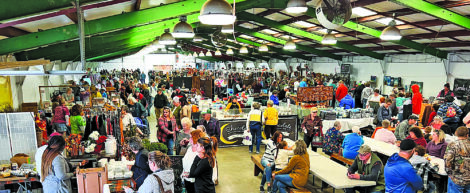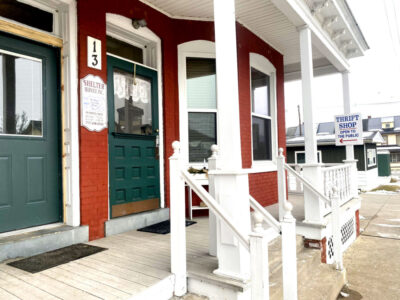Softball tournament to benefit local child
MIFFLINTOWN — You don’t notice the size of the ball, not at first. What you notice is the sound: the quiet thump of leather against palm, the sudden chorus of kids at play, the echo of a mother’s voice–someone’s mother, someone’s friend–carrying across Walker Park as the sun angles down and a breeze turns the outfield grass silver. The ball looks huge until it’s in motion. Until you try to hit it. Until you remember that what’s supposed to be easy almost never is.
Every September, the families gather, and this year–year eleven–the ritual begins again. The 11th Annual Harper’s Warriors 16″ Benefit Softball Tournament, a benefit named for a girl who never took a breath outside her mother’s arms, but whose name is now said more often, and more gently, than almost any other in this small county.
“We base our foundation around the symbol of the butterfly,” said Allessa Wagner, vice president of the Harper’s Warriors Foundation, her voice both matter-of-fact and reverent, as if explaining a local law. “That is what they put on the headstone for Harper. That was her headstone. Big butterfly, big monarch butterfly. So anything butterfly-related is always a pretty good sign.”
This year’s tournament honors three remarkable children and their families. Alexis Merritt is a 6-year-old bravely battling leukemia while also living with Down syndrome, facing a daily struggle that would test anyone many times her age.
Brielle Lindstrom was born premature and now faces 1P36 Deletion Syndrome, dealing with ongoing breathing and heart challenges that require constant care and specialized treatment.
Payton Koza is a strong fighter, overcoming significant medical struggles after a devastating head-on collision caused by a wrong-way driver. Each family lives with uncertainty and hardship, but for one day, they will stand at the center of a community’s love and support.
The first year, it was friends and family, a handful of teams and a need so raw it hurt to talk about. Harper Lynn Miller was born still, her hands folded in prayer, her mother’s faith, Amber Foose Miller, already bracing itself for what would follow: the bills, the silence, the hunger to do something, anything, that might keep her daughter close.
In the first year, the community gathered, and what they raised paid for a grave marker that would not fade, and for a few moments of peace, which is what all these families are really buying, year after year.
The event got bigger because grief isn’t unique, and neither is generosity. There are more stories now–Alexis, Brielle, Payton. Three families this year, chosen after long nights and longer prayers, their applications weighed not against each other but against the board’s own sense of mercy.
“Every year we get together, we have a huge board,” Wagner said. “There’s about five or six of us that are on the board, plus we have different community volunteers that reach out to help out with the foundation itself.”
Wagner is transparent about the process: “We have an actual application process. It doesn’t ask any personal questions. But it asks the name of the recipient, the parent’s name, the number of people in the household, if the person needs medical assistance, if they have all their medical bills paid for by their insurance, and if not, what is not paid for by the insurance.”
You are there, watching a seven-year-old chase a ball that seems too big for his hands. You see Amber’s other children–Carson, Letty, and Raya–running in the grass where Harper’s memory lives. A butterfly crosses the outfield, and for a second, everyone stops. It’s a superstition, maybe, or it’s something real. “Anytime, you know, it’s amazing. They’ll be out playing, and a butterfly will go across them. And there’s Harper. You know, it’s amazing. It is. It’s awesome,” Wagner said.
You decide what you want it to mean.
Some years, ten thousand dollars is raised. Sometimes it’s less. Every cent that comes in goes back out; the accountants see that nonprofit status makes it law, but what really guarantees the money goes where it should is the weight of a small county’s attention.
“As far as the funding, 100% of the proceeds that come in that day go right back out. We are an official nonprofit organization, so we have an accountant that takes care of all of our record keeping and stuff like that,” Wagner said.
Umpires donate their time; local businesses pitch in with baskets for the auction, snacks for the concession stand, and prizes big and small. This year, there are Phillies tickets, Steelers tickets, Penn State gear, children’s books from the hospital in Hershey. The list grows until someone asks, “Do we have enough?” The answer, always, is yes and no.
The children’s craft corner is ready. There’s face painting, a playground, sun catchers, and the annual appearance of Rita’s Italian Ice. It isn’t complicated, but it is enormous–the text thread among organizers is a living thing, 60 or 70 unread messages after a shift, logistics and hope blurring into each other.
“We have a huge group chat, the board members going nonstop this month. It’s nothing for me at the end of the day to have 60 to 70 missed messages. Hey, we got this. Hey, we got this. Hey, can somebody pick this up?” Wagner laughs. “You know, like we’ve had upwards of close to or over 200 baskets in one given day, and that’s where a lot of our profit comes from, for the tournament itself.”
Ask Allessa what it feels like when the day arrives? She talks about the cold mornings, the fields that sometimes flood, the hope for good weather, and the moments when you see someone look up, catch sight of the butterfly, and smile. “You can’t explain it until you’ve witnessed it,” she said, and you know she’s right.
It isn’t about skill–half the men who play every year can’t even hit the ball. “It is a huge ball. You know, you see these grown men who play so much softball all the time, they can’t even hit the ball. It’s pretty interesting to watch. Honestly, the environment there is amazing.”
The ritual is what matters–the ball thrown, the bat swung, the voices raised in half-laughter and half-memory. The contradiction lives in the joy and the ache: what began as a memorial has become a lifeline, what started in grief is now a carnival, what could have ended in silence now rings out every September, clear and insistent as the wind chimes sent to grieving parents, the only sound that says, “Your child is near. We are near.”
It isn’t enough, but it’s something. The butterfly returns each year, and every time you notice it, you remember. Every time you don’t, someone else does. The game is played until the sun drops behind the hills, and the teams gather for a photo, holding bats and small children, and the bright, awkward, yet necessary hope that next year, the ritual will be needed less, but practiced more.
If you find yourself at Walker Park at 8 a.m. Sept. 27, bring something to give–time, a basket, a check, a word of encouragement, a hand. You won’t notice the size of the ball at first, but you’ll remember what it feels like to swing at something bigger than you, and maybe, this year, to connect.


